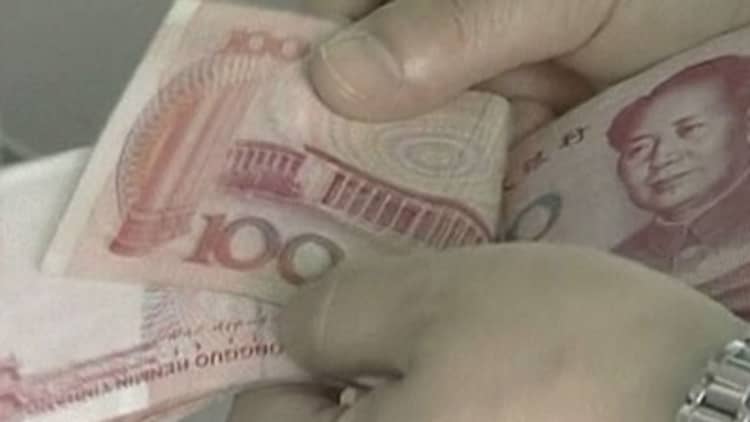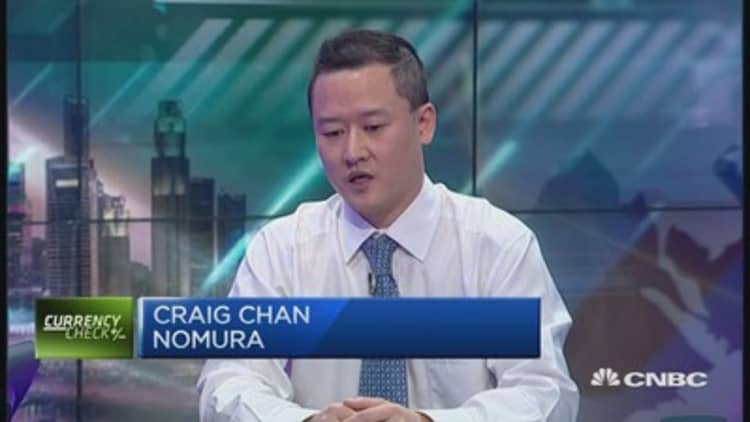
The Chinese yuan plunged to a five-year low in offshore trading and the gap between it and its mainland counterpart widened sharply on Wednesday, reflecting growing expectations of further weakness in the currency amid an economic slowdown and a slump in stock markets.
The offshore yuan fell to 6.6915 against the greenback, the lowest rate of exchange since at least the last quarter of 2010 and a 2.1 percent discount to the onshore yuan's 6.5506 level. While the yuan is primarily traded on the mainland and subject to strict central bank supervision, its offshore counterpart is accessible to everyone.
"The spread between the onshore and offshore yuan has now reached some of the highest levels in the pair's history – a clear indication of both volatility and intervention," said Angus Nicholson, a market strategist at IG.
Markets generally expect the onshore yuan to continue depreciating against the dollar on the back of sluggish growth prospects, accelerating capital outflows and demand for overseas assets.
"The combination of weak cyclical and structural forces is seen working against the currency," HSBC analysts said in a research note. "In the near-term, there could be stronger dollar demand against the onshore yuan as the latter's depreciation expectations remain entrenched."
The latest trigger for the slump came after the People's Bank of China (PBOC) set the onshore yuan midpoint rate at 6.5314 per dollar, the weakest fixing since 2011.
The fix represented a 0.22 percent decline from the previous session, a faster pace than witnessed recently. This was despite Tuesday's suspected intervention by the central bank to halt currency declines.
Analysts said the somewhat confusing message—buying yuan in the secondary market only to guide it lower the next day—was part of the PBOC's plan to let the onshore yuan reflect market forces.
"To achieve a more market-balanced yuan, the PBOC has to ensure an orderly depreciation before they can see an eventual appreciation in the currency," explained Maybank analysts in a note, calling the increased volatility "a natural order of change."
The widening spread between the offshore and onshore rates may be used as a gauge as to how much more the latter will have to adjust before it reaches an equilibrium level, Maybank added.
"In fact, we think that the next time the offshore and onshore rates converge completely, it could mark the beginning of the end of the offshore yuan."
The two rates have converged numerous times during the last five years, most recently around the 6.35 level last October.

A sharp fall in the onshore yuan would test the resolve of policymakers around the world, just months after the International Monetary Fund's (IMF) executive board announced plans to include the currency in its Special Drawing Rights (SDR) basket.
A sustained weakness in the currency could also hasten capital outflows that have already bedeviled financial markets. And falls in the yuan, coupled with the strength in the dollar, could increase political friction ahead of U.S. Presidential elections.
A resolute defense of the onshore yuan also comes at a cost.
Continuing to prop it up would take a toll on China's (still sizable) foreign exchange reserves, while straining the amount of spare cash in the banking system. Plus, excessive meddling in financial markets is bound to raise doubts on China's commitment to market reforms.
Still, some analysts believe there are risks that the onshore yuan falls more slowly onshore due to central bank interventions, which could derail the PBOC's target of a more free currency.
"Depreciation could result in a global market sell-off that ranges from Asia FX to broad equity market weakness," warned Nomura analysts in a recent note, adding that increased widening of onshore/offshore rates could also prompt authorities to intervene in offshore rates.
Maybank is betting the yuan to hit 6.7 per dollar by year-end while Nomura sees it at fair value of 6.9.


